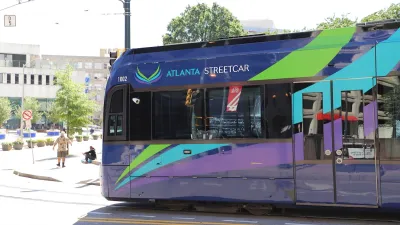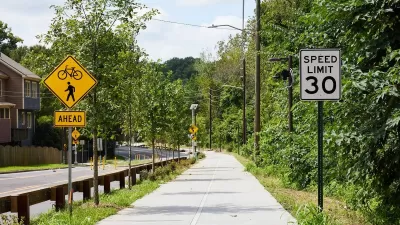With just two miles of an eventual 22 transformed from old rail tracks to trails, Atlantans are enjoying a taste of the planned $2.8 billion BeltLine. Despite its early success, the future of the ambitious project is far from settled.
Plans for the Atlanta BeltLine are certainly bold: the 22 miles of old railroad tracks planned for conversion into parks, housing, and public transit would be the most expensive rails-to-trails project ever completed. "It would add 40 percent more parks to Atlanta. Only 4.6 percent of Atlanta is parkland, compared with 25 percent in New Orleans and 19 percent in New York."
The first phase of the project, the two-mile Eastside Trail, has been popular with joggers, bikers, and commuters - a good sign in this notoriously car-dependent city. And the project has some influential backers, including Mayor Kasim Reed who's proud of the significance of the effort. “We are changing Atlanta into a city that you can enjoy by walking and riding a bike,” said the Mayor. “We have been so car-centric that you didn’t experience the city in an intimate way.”
However, as Robbie Brown reports, "[c]ountless obstacles remain — from purchasing land, digging up decades-old tracks and routing the trail around operating trains and freight yards. But the greatest challenge is financing. The city and a host of nonprofits have raised $350 million through private donations and property taxes on the $2.8 billion project."
"Critics have urged that the project be scaled back. The city’s biggest transit challenge, they argue, is not beautifying in-town neighborhoods but reducing gridlock from the suburbs."
If the boom in construction along the Eastside Trail is any indication, the project's momentum may be enough to drive it forward, despite the critics.
“People want to live in a city where the design makes sense,” said Ryan Gravel, whose graduate thesis sparked the project. “It’s not only changing the physical form of the city. It’s changing the way we think about the city.”
FULL STORY: Now Atlanta Is Turning Old Tracks Green

Alabama: Trump Terminates Settlements for Black Communities Harmed By Raw Sewage
Trump deemed the landmark civil rights agreement “illegal DEI and environmental justice policy.”

Planetizen Federal Action Tracker
A weekly monitor of how Trump’s orders and actions are impacting planners and planning in America.

The 120 Year Old Tiny Home Villages That Sheltered San Francisco’s Earthquake Refugees
More than a century ago, San Francisco mobilized to house thousands of residents displaced by the 1906 earthquake. Could their strategy offer a model for the present?

In Both Crashes and Crime, Public Transportation is Far Safer than Driving
Contrary to popular assumptions, public transportation has far lower crash and crime rates than automobile travel. For safer communities, improve and encourage transit travel.

Report: Zoning Reforms Should Complement Nashville’s Ambitious Transit Plan
Without reform, restrictive zoning codes will limit the impact of the city’s planned transit expansion and could exclude some of the residents who depend on transit the most.

Judge Orders Release of Frozen IRA, IIJA Funding
The decision is a victory for environmental groups who charged that freezing funds for critical infrastructure and disaster response programs caused “real and irreparable harm” to communities.
Urban Design for Planners 1: Software Tools
This six-course series explores essential urban design concepts using open source software and equips planners with the tools they need to participate fully in the urban design process.
Planning for Universal Design
Learn the tools for implementing Universal Design in planning regulations.
Clanton & Associates, Inc.
Jessamine County Fiscal Court
Institute for Housing and Urban Development Studies (IHS)
City of Grandview
Harvard GSD Executive Education
Toledo-Lucas County Plan Commissions
Salt Lake City
NYU Wagner Graduate School of Public Service





























